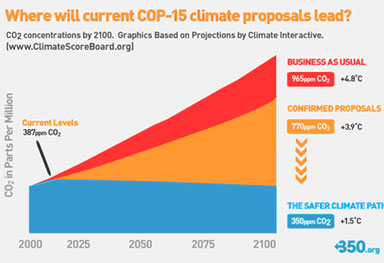World governments are nowhere close to staying below the 2°C (3.6 °F) temperature rise threshold they have promised to avoid, and new research shows even that level is too high to prevent disaster from climate change.
17 leading climatologists including James Hansen believe the upper limit must be set at 1°C (1.8°F) instead, which would keep atmospheric carbon levels at 350 ppm. Currently, we are at 0.8°C – awfully close. Achieving the 2°C target would bring us to 450 ppm.
Allowing a 2°C rise will likely result in sea level rise on the order of 20 feet, while inducing "slow amplifying feedback" such as minimal ice sheets and rising methane and nitrous oxide levels in the atmosphere. At that point, the situation would be out of humanity’s control because it would take many centuries for oceans to cool down.
The earth’s climate has to stay in the Holocene range – the temperature range of the past 10,000 years – to keep these slow feedbacks small, they conclude.
It CAN Be Done
Although it may seem like a futile exercise, given that worldwide emissions are still rising, Hansen and his colleagues believe it is an achievable goal. It can be accomplished by limiting cumulative fossil fuel emissions to 500 gigatons and by pursuing public policies that sequester 100 gigatons of that into the soil and forests.
We can reduce atmospheric carbon to 350 ppm by 2100, they say, which would restore Earth’s energy balance and stabilize the climate. It can be achieved if emissions from burning fossil fuels are reduced 6% a year from 2013 and through reforestation.
If the world allows fossil fuel emissons to keep growing through 2020, they would have to cut by 15% a year starting then.

The research team, which includes three economists, recommend – once again – a carbon tax that would be collected from fossil fuel companies.
"An advantage of a carbon fee or tax is the relative ease with which it can be made global [quickly]," they say. "An agreement among even a few of the largest economies (United States, China, European Union, Japan) could spur near-global agreement. Countries agreeing to have a rising carbon fee would likely place border duties on products from countries without a carbon fee, thus providing strong incentive for countries to join."
If nothing is done soon, "The huge fossil fuel energy infrastructure now in place makes it practically certain that the 500 billion metric ton limit will be exceeded," they say. At this pace, temperatures will rise at least a 6°F by the end of this century.
With a price on carbon, solar can provide a third of the world’s energy by 2060, says the International Energy Agency, and renewables could provide 80% by 2050. Other studies show we can get there even faster.
Indeed, this year, carbon levels briefly hit 400 ppm – the highest recorded in human history – and are expected to climb as high as 450 ppm by mid-century if emissions continue on their current course.
"It seems that we’re just charging ahead, finding and burning as much fossil fuels as we can possibly find," Hansen says. "There seems to be no real effort to get off that business-as-usual path.
"Besides a carbon tax, governments need to support technology R&D and demonstration of carbon-free energy, "including advanced generation nuclear power, as well as renewable energy, especially in view of the urgency with which emissions from coal and unconventional fossil fuels [tar sands, shale-derived oil and gas, and methane hydrates] must be eliminated.
"On the 50th anniversary of John F. Kennedy’s death, it is worth remembering his 1963 peace speech: ‘No problem of human destiny is beyond human beings. Man’s reason and spirit have solved the seemingly unsolvable-and we believe they can do it again," says Hansen.
True, but it’s hard to imagine how we will stop fossil fuel expansion in its tracks so quickly. The US is producing more oil and gas than ever before and other nations are following suit.
Read, "Assessing ‘Dangerous Climate Change: Required Reduction of Carbon Emissions to Protect Young People, Future Generations and Nature":
